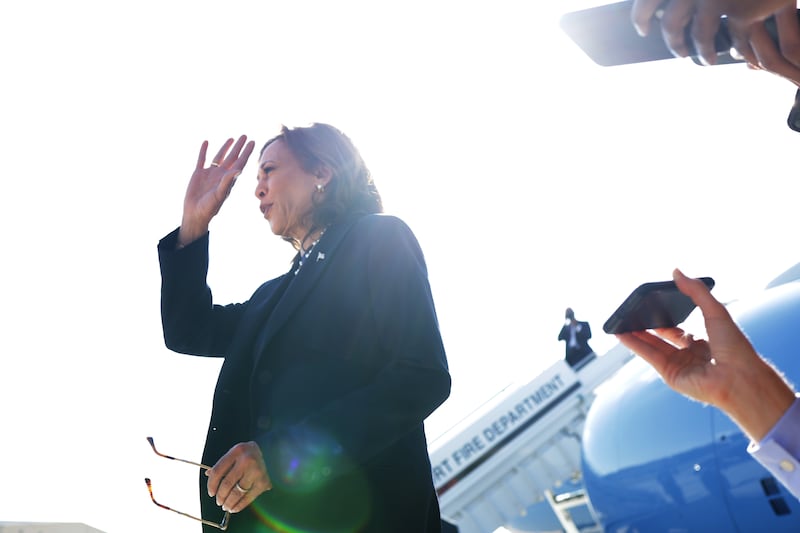The press has questions for US vice-president Kamala Harris. She isn’t giving many answers.
In the nearly three weeks since President Joe Biden withdrew his candidacy, catapulting Harris to the top of the Democratic ticket, the vice-president has shown little eagerness to meet journalists in unscripted settings. She has not granted an interview or held a news conference. On Thursday, after a rally in Michigan, she held her first “gaggle” – an impromptu Q&A session – with reporters covering her campaign.
It lasted 70 seconds.
Harris replaced a Democratic nominee who has hosted fewer White House news conferences than any president since Ronald Reagan. Now she is taking a similarly cautious approach, relying on televised rallies and prepared statements amid a tightly controlled roll-out of her candidacy.
READ MORE
Asked on Thursday if she might sit for an interview soon, Harris suggested that she would get through the convention first. “I want us to get an interview scheduled before the end of the month,” she said, as aides signalled to the scrum of journalists that question time was over.

Harris’s lack of engagement with the media has become a constant rallying cry on the political right, with Republican critics and Fox News stars accusing the vice-president of ducking scrutiny. The Harris campaign says it is being thoughtful about how best to deploy its message, and to introduce a new candidate to crucial voters in battleground states.
David Axelrod, the architect of former president Barack Obama’s winning campaigns, said he believes that Harris – who on Thursday said she had agreed to a prime-time debate with former president Donald Trump on September 10th – was trying to strike a balance.
“This has been a whirlwind few weeks, and right now, buoyant rally speeches are working really well, so she’s riding the wave,” Axelrod wrote in an email. “But I’m sure they know that, in addition, presidential races impose a series of tests, including debates and unscripted interactions with voters and media, by which people come to know you. There is time, and I’m sure she’ll get there.”
Her opponent, Trump, has a less generous view.
“She doesn’t know how to do a news conference; she’s not smart enough to do a news conference,” Trump said during a discursive news conference on Thursday in Florida. “She won’t do interviews with friendly people because she can’t do better than Biden,” Trump added. “She should be doing interviews. She doesn’t want to do interviews.”
Fox News, which carried Trump’s news conference live, echoed the former president’s attacks, displaying an on-screen headline that read, “Trump Takes Questions as Harris Dodges.”
Harris has fielded some questions from journalists, but out of the public eye. On several occasions since becoming the presumptive nominee, she has held off-the-record meetings with reporters in the back of her campaign plane. Biden rarely held these sessions; this week, though, he opened himself to scrutiny in an interview with Robert Costa of CBS.
Some political strategists say Harris is doing exactly what she should be doing. Her campaign rallies have been widely covered, and a kickoff event on Tuesday with her running mate, governor Tim Walz of Minnesota, was watched live on cable news by nearly eight million people. Big interviews, early on in a candidacy, also carry big risks: witness Sarah Palin’s fiasco with Katie Couric.
“Where is it written that you have to sit down for a press interview?” said James Carville, Bill Clinton’s long-time messaging guru. “They’ve had to pick a vice president, plan a convention, move around, do this, do that, and she’s already agreed to a debate.”
Carville said that Harris was wisely managing her time, given the extraordinary task of embarking on a presidential campaign three months before election day. He imagined a plea from a reporter – “‘Come talk to me for 45 minutes’” – and then offered how the campaign might respond: “Oh, shut up!”
Trump has granted several interviews in recent weeks, albeit to a heap of highly sympathetic media outlets, including the livestream of an internet celebrity who presented him with a gold Rolex, and Sid & Friends in the Morning, a Trump-friendly New York drive-time radio show. Trump faced tougher questions when he appeared at last week’s convention of the National Association of Black Journalists, and again at Thursday’s news conference, which stretched for 65 minutes.
Harris’s record with big interviews is mixed. An appearance in 2021 with Lester Holt of NBC went poorly and raised concerns within the Biden administration. Since then, Harris has cultivated relationships with media stars such as Joe Scarborough and numerous White House correspondents. In her most recent TV interview, on CNN immediately following the June debate, Harris comfortably addressed Biden’s poor performance.
Aides to Harris argue that in a fractured media landscape, where trust in traditional news outlets has fallen, their most effective voter outreach comes from alternative venues such as TikTok and their own social media platforms.
“The vice-president’s top priority is earning the support of the voters who will decide this election,” Kevin Munoz, a spokesperson for Harris, said on Thursday, adding that the campaign was “being strategic, creative and expeditious” in using TV ads, rallies, local organisers, “and of course interviews that reach our target voters”.
He did not say when such an interview might take place.
– This article originally appeared in The New York Times.
2024 The New York Times Company














